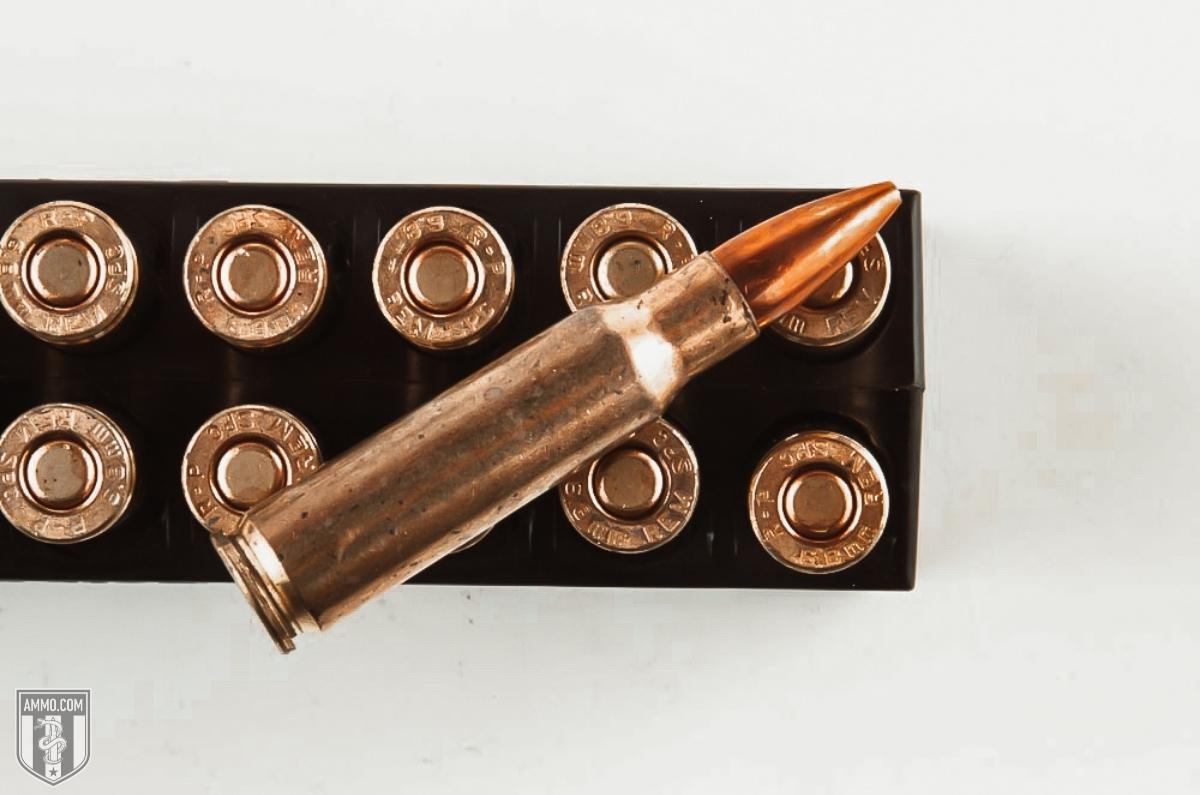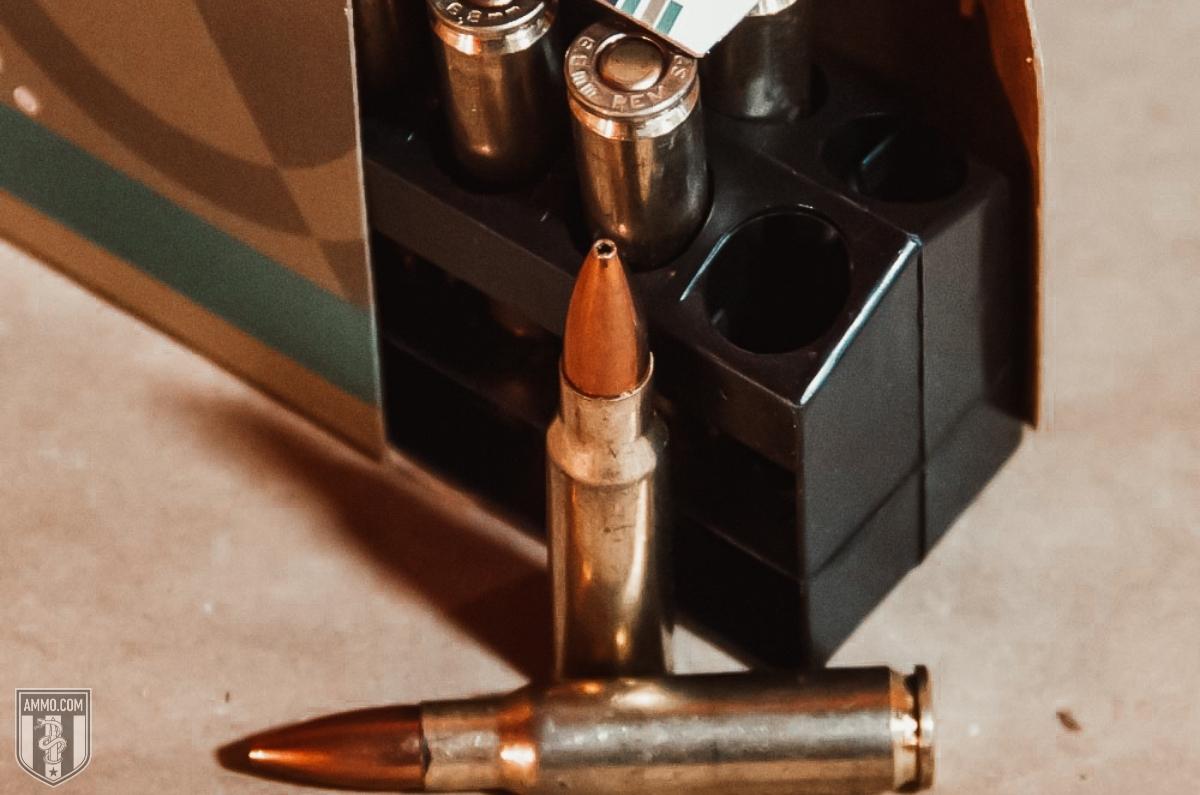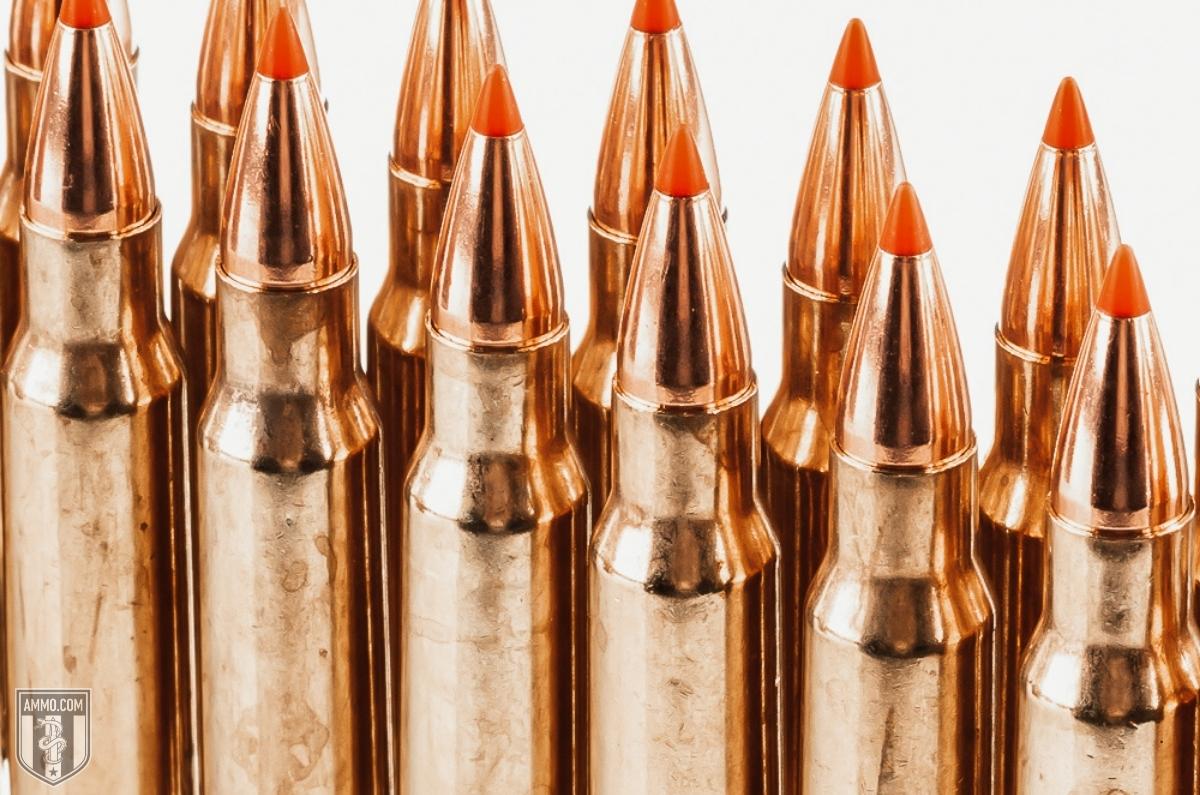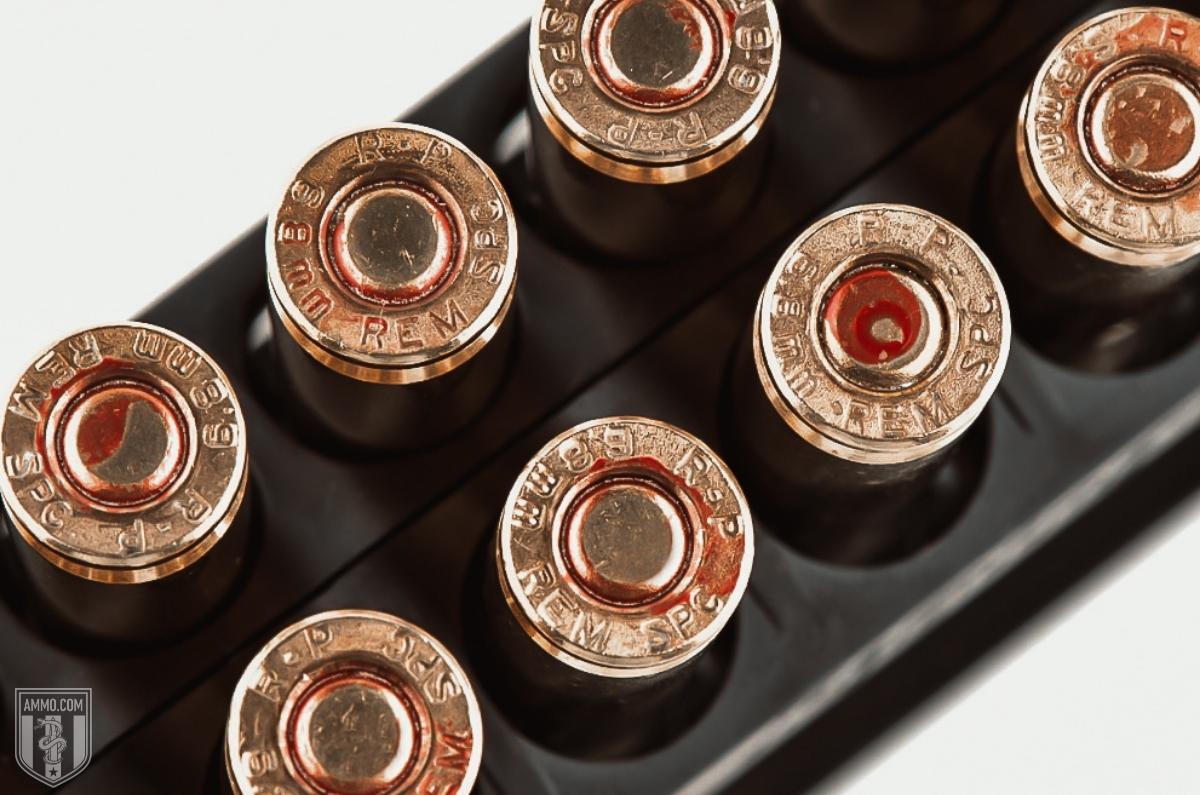6.8 Western vs 6.8 SPC: The 6.8 Caliber Showdown
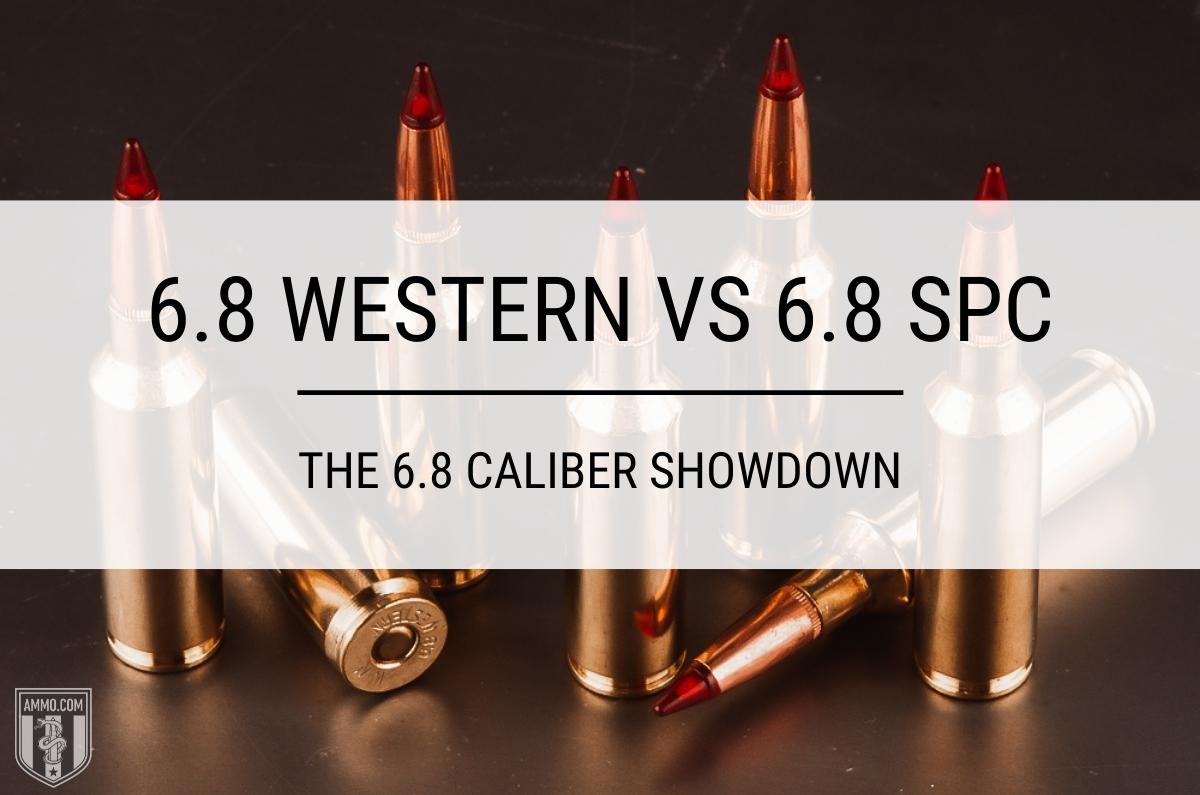 The 6.8 caliber has had difficulty achieving wide-spread acceptance by the 2A community in the United States. We love our 223 Remington, 300 Blackout, and 308 Winchester, shying away from anything metric not named 9mm.
The 6.8 caliber has had difficulty achieving wide-spread acceptance by the 2A community in the United States. We love our 223 Remington, 300 Blackout, and 308 Winchester, shying away from anything metric not named 9mm.
The 6.8 Remington SPC and 6.8 Western are two cartridges that have not become as popular as they ought to be. Living in the sweet spot between the 308 and 223, the 7mm bullet diameter offers shooters ridiculously high ballistic coefficients, low felt recoil, and exceptional long-range shooting capabilities.
Although the 6.8 SPC and 6.8 Western occupy the same caliber slot, they have wildly different capabilities as they were designed with different purposes and applications in mind. The 6.8 SPC was designed for the AR-15 semi-automatic sporting rifle while the 6.8 Western was designed as a hunting cartridge for bolt-action rifles.
In this article we will compare the 6.8 SPC vs 6.8 Western to give you a better understanding of each and help you make the decision which is best for your shooting needs.
What is the difference between 6.8 SPC and 6.8 Western?
The primary difference between the 6.8 Western vs 6.8 SPC is in their case design. The 6.8 Western has a higher case capacity and is capable of firing heavier bullets at higher muzzle velocities from bolt-action rifles while the 6.8 SPC was designed for use in the semi-auto AR-15 as an upgrade to the 5.56 NATO.
Cartridge Specs
When evaluating centerfire rifle cartridges, it’s a good idea to analyze the cartridge specs to gain more knowledge of each.
The most obvious similarity between the two rifle cartridges is that they fire the same diameter bullets at 0.277”. However, this is where the similarities end, as the 6.8 Western typically fires longer, heavier bullets from 160-185 grains while the 6.8 SPC fires bullet weights from 85-140 grains.
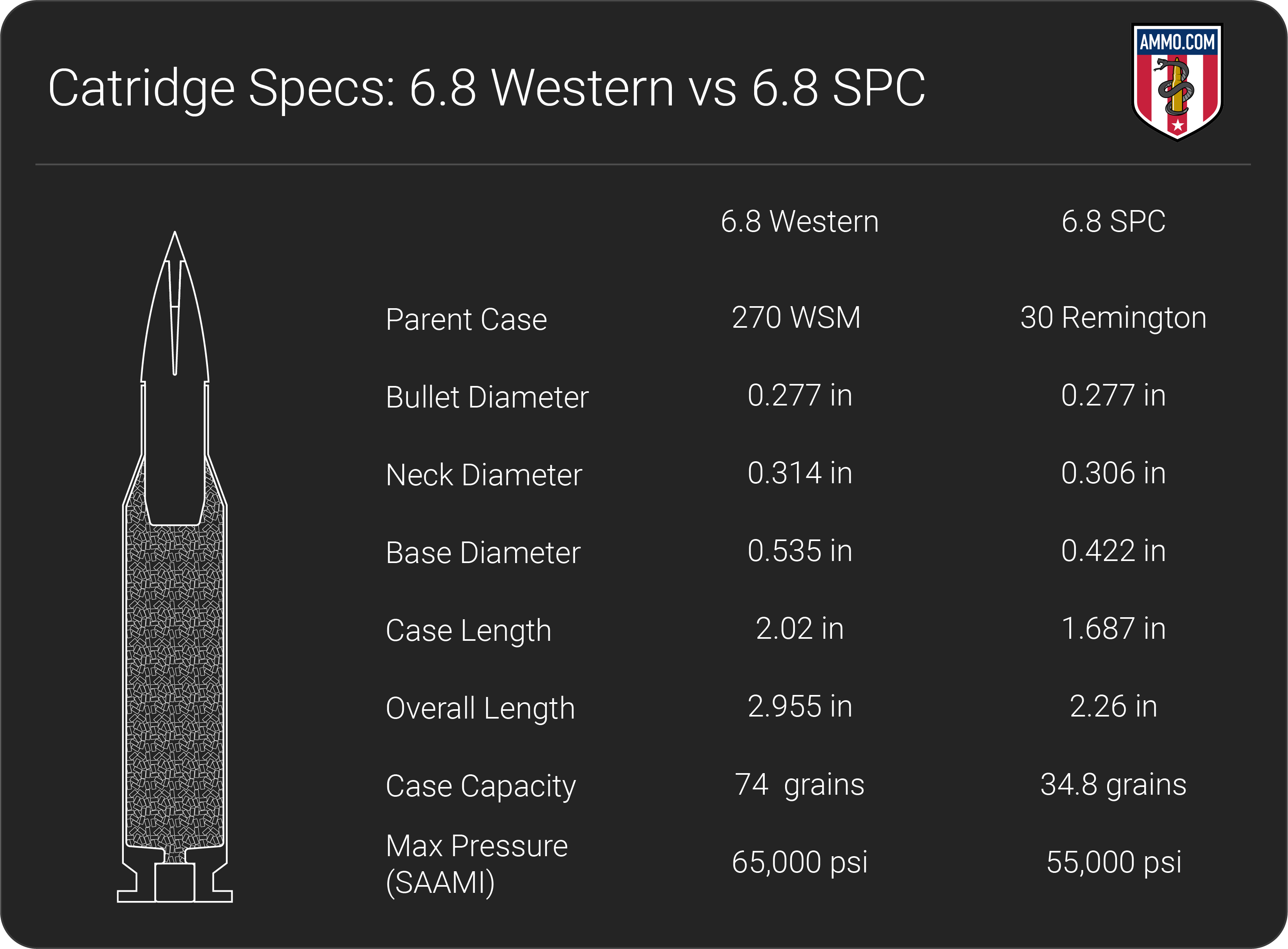
The first major difference to consider is the parent case that both 6.8’s descend from. The 6.8 SPC was born from the venerable 30 Remington, which also gave us the 10mm Auto and 224 Valkyrie, while the 6.8 Western cartridge was born from the 270 Winchester Short Magnum (WSM). This puts the 6.8 Western firmly in the realm of being essentially a short magnum without the “SM” suffix attached to its name, as it is a mere 2.2mm shorter than the 270 WSM.
Short magnum rounds were designed to fit in a short action while still maintaining their magnum-level terminal ballistics. As such, they have a shorter overall length but are wider than many other magnum cartridges to maintain the needed case capacity for long range shooting. However, the 6.8 SPC is restricted to the chamber design of the AR-15 carbine as it was designed to be a potential replacement for the 5.56 NATO for CQB applications. As such, the 6.8 SPC is the shorter of the two rifle cartridges at 2.26” compared to 2.955” for the 6.8 Western.
The 6.8 Western is also considerably wider than the 6.8 SPC, as the Western cartridge needs more space to pack in all that extra gun powder. The 6.8 Western has a base diameter of 0.535” compared to 0.422” for the Remington SPC.
In terms of case capacity, the 6.8 Western has over double the capacity compared to the 6.8 SPC. Measuring a whopping 74 gr of case capacity, the 6.8 Western dominates the 6.8 SPC that can only hold 34.8 gr powder at the most. This drastic difference showcases the design concepts behind each cartridge, as the 6.8 Western was designed to fire heavier bullets with a higher ballistic coefficient for long-range shooting while the 6.8 SPC was developed for CQB applications from a short-barreled rifle (SBR) like those employed by US military personnel in the second Iraq War.
Finally, as the 6.8 Western is essentially a magnum round, it can handle considerably higher pressures than the 6.8 SPC. Based on SAAMI specs, the 6.8 Western can withstand a maximum of 65,000 PSI chamber pressure compared to 55,000 for the 6.8 SPC.
Recoil
The 6.8 Western has considerably more recoil than the 6.8 SPC as the Western cartridge has a higher case capacity and fires heavier bullets.
Recoil is an important consideration when purchasing a new rifle as a round with heavy recoil will be more difficult to control and will slow your rate of follow up shots.
Recoil is affected primarily by muzzle velocity (FPS), powder charge, bullet weight, and rifle weight.
As the 6.8 Western fires heavier bullets and has over double the case capacity of the SPC, it’s not surprising that it has higher recoil.
Given that a standard 6.8 Western rifle like the Browning X-Bolt weighs around 8 lbs and Winchester Silver Tip 170 grain ammo has a listed muzzle velocity of 2,920 fps, we would expect the 6.8 Western to have a free recoil energy of around 27 ft-lbs. To put this into perspective, the 6.8 Western has about the same free recoil as the 7mm Rem Mag or 300 Winchester Magnum, albeit slightly less.
On the other hand, the 6.8 SPC is typically fired from the AR-15 carbine weight an average of 7 lbs. Firing a Hornady Custom 120 grain bullet at 2,460 fps will give the 6.8 SPC a free recoil measurement of around 9 ft-lbs of energy.
On average, the 6.8 SPC will have approximately 3x less recoil than the 6.8 Western.
Muzzle Velocity and Kinetic Energy
The 6.8 Western leaves the 6.8 SPC eating its dust in terms of muzzle velocity and muzzle energy.
The 6.8 Western boasts an impressive 2,970 fps and 3,226 ft-lbs of energy when firing a 165 gr Accubond Long Range bullet. This is similar to the ballistic performance of the 7mm Rem Mag, except the 6.8 Western fits into a short action.
Comparatively, the 6.8 SPC can fire a Hornady V-MAX 110 grain bullet at 2,550 fps with 1,588 ft-lbs of energy.
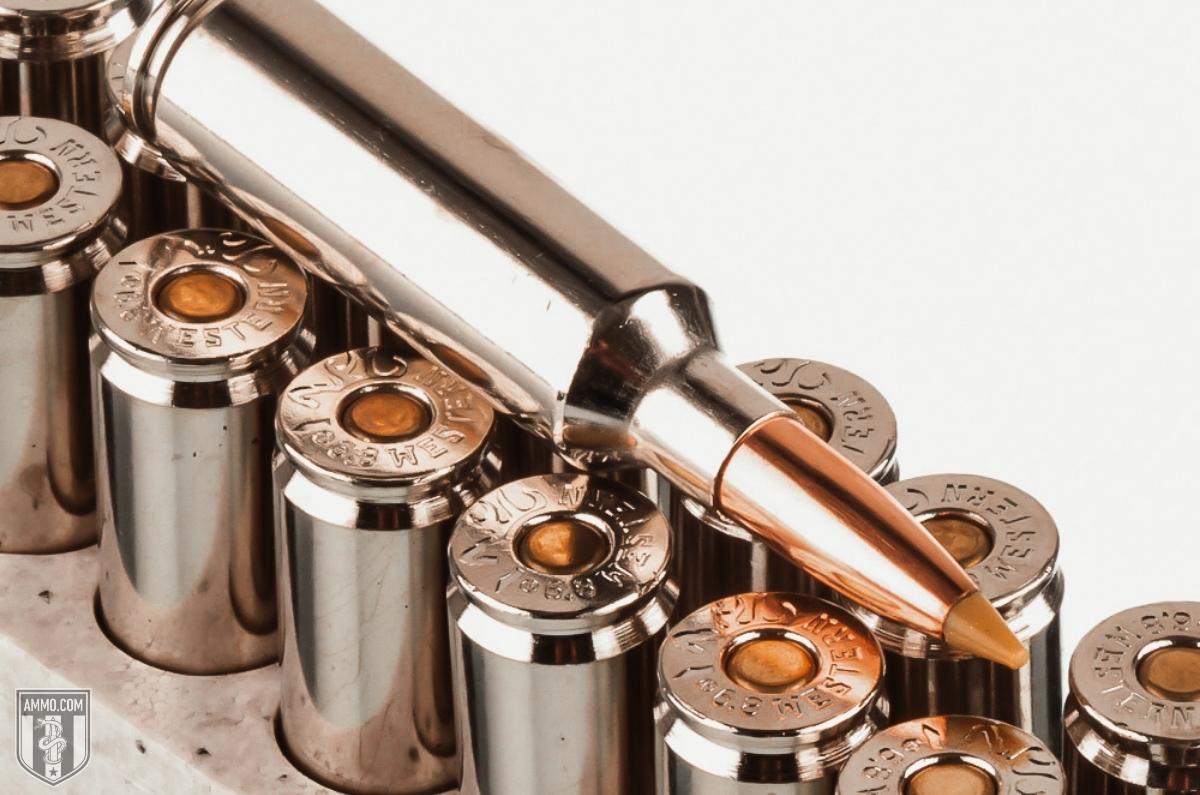
With double the case capacity, it’s not surprising that the 6.8 Western can attain higher muzzle velocities and energies than the 6.8 SPC.
Trajectory
The 6.8 Western is the flatter shooting round due to its higher muzzle velocity.
Trajectory is how we quantify a bullet’s flight path as it travels downrange measured in inches of bullet drop.
Obviously, a flatter shooting cartridge is preferred for long-range shooting, as a shooter will require fewer adjustments to their optics to compensate for bullet drop. Having a flatter trajectory also means that a cartridge will be more forgiving of ranging mistakes.
Assuming a 100 yard zero, a Winchester 165 gr Accubond Long Range 6.8 Western round will have -24” of bullet drop at 400 yards compared to -40” for the 6.8 SPC.
As the 6.8 Western has a higher muzzle velocity, it will reach the target faster and gravity will have less time to affect its flight path. This is one of the main reasons why it is an exceptional long range rifle cartridge.
Ballistic Coefficient
The 6.8 Western cartridge was designed to fire heavy, sleek, aerodynamic bullets and, therefore, dominates in terms of ballistic coefficient.
Ballistic coefficient (BC) is a measure of how well a bullet resists wind drift and air resistance. Put another way, it’s a numeric representation of how aerodynamic a bullet is. A high BC is preferred as this means the bullet will buck the wind easier.
Generally, heavy bullets will have a higher BC as it takes more force to disrupt the flight of a heavier bullet than a lighter one. Ballistic coefficient varies from bullet to bullet based on design, weight, and other factors that are beyond the scope of this article.
When developing the 6.8 Western, the ballisticians at Winchester started with the expectation of the cartridge firing a bullet with a BC no less than 0.60. This meant the 6.8 Western needed to be capable of firing 160-170 grain bullets, which was one shortcoming of other 0.277” cartridges like the 270 Winchester and 270 Weatherby Magnum. The slower 1:10 barrel twist rate restricted these cartridges to 130-150 grain bullets that could not achieve such high BC values. As the 6.8 Western has a faster 1:8 barrel twist rate per SAAMI specs, it can handle the heavier bullet weights that long range shooters prefer.
On average, the 6.8 Western will have a BC at or above 0.60. For example, the Browning 175 gr Long Range Pro Hunter bullet has a BC of 0.617 for 6.8 Western. On the other hand, the 6.8 SPC typically has a maximum BC of 0.45 for bullets like the 140 grain Sierra GameKing.
As the 6.8 Western was built for long range shots while the 6.8 SPC was built for CQB, it’s not surprising that the 6.8 Western has a higher BC.
Sectional Density
The 6.8 Western will generally have a higher sectional density when compared to the 6.8 SPC.
Sectional Density (SD) is the measure of how well a bullet penetrates a target. This is extremely important when hunting big and medium sized game, as you need a bullet that can punch through thick hide, bone, and sinew.
Sectional density is calculated by comparing the bullet weight and the bullet diameter. The higher the SD the deeper the bullet will penetrate into the target. This is a simplified view of penetration as there are other factors to consider, such as bullet expansion and high velocity.
As the 6.8 Western fires a heavier bullet at higher muzzle velocities, it will typically have a higher SD than 6.8 SPC. For example, the 175 gr Sierra Tipped GameKing bullet for 6.8 Western has a SD of 0.326 compared to the 120 gr Hornady SST bullet for 6.8 SPC that has a SD of 0.223.
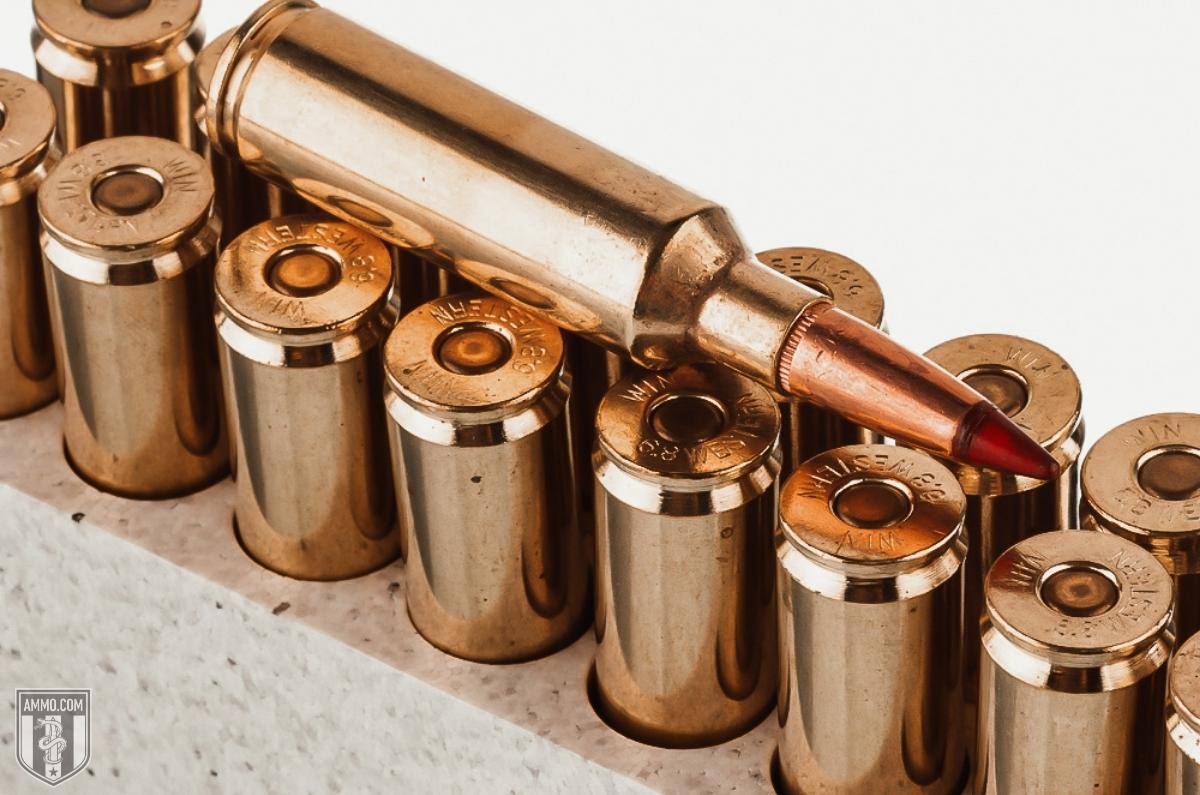
Hunting
The 6.8 Western and 6.8 SPC are both excellent big game hunting cartridges. The 6.8 SPC is a great option for whitetail, hogs, and varmints while the 6.8 Western is best suited for deer, elk, and black bear.
For varmint hunting, the 6.8 SPC is the better choice, albeit still a little much for smaller critters. The SPC has lower bullet weight options like the 110 gr Hornady V-MAX which will make short work of pests and varmints on your property. However, most varmint hunters prefer a lighter, faster, and flatter shooting bullet as opposed to a heavier option like the Remington SPC. Usually, varmint hunters prefer the 223 Remington or 22-250 for these animals, but the 6.8 SPC can do the job in a pinch. The 6.8 Western is inappropriate for varmints as it is too powerful of a hunting cartridge for these smaller targets.
The real controversy begins when we get into whitetail territory, as both rifle cartridges will be certain to put venison on the table and in the freezer. One aspect to consider is that the maximum range for the 6.8 SPC on a whitetail is around 200-250 yards depending on your factory load of choice. This is the range where the SPC round begins to dip below the 1,000 ft-lb threshold, which is considered the lower limit of kinetic energy for ethically harvesting a whitetail. On the other hand, the 6.8 Western is still packing around 1,700 ft-lbs of energy at 500 yards, which is more than enough to harvest an elk, let alone a deer.
Selecting the appropriate deer cartridge between 6.8 Western vs 6.8 SPC revolves primarily around what range you’ll be shooting at. If you will be shooting under 250 yards, the 6.8 SPC is clearly the better choice as it has 1/3 the recoil which will allow for faster follow-up shots if they are needed. However, if you expect to shoot further than 250 yards, the 6.8 Western is a better choice.
For big game like elk and black bear, the 6.8 Western is the clear choice as it fires heavier bullets at higher muzzle velocities with insane kinetic energy values. The 6.8 Western still retains enough kinetic energy to take down an elk at 500 yards, making it the clear choice for long range big game hunting.
Ammo and Rifle Cost/Availability
Although neither round is cheap, the 6.8 SPC is less expensive and easier to find than the 6.8 Western.
As the 6.8 Western is a new cartridge, only Winchester and Browning currently produce ammo for the round. There are currently only 5 different options available for 6.8 Western ammo, with the least expensive being Winchester 162 gr Copper Impact at $3/round and most expensive option being the Winchester 165 gr AccuBond Long Range at $4.60/round
On the other hand, the 6.8 SPC has considerably more factory loads available to the shooting community at more affordable prices. The most affordable option being the Silver State Armory 85 gr Nosler E-Tip coming in around $1.50. Other full metal jacket (FMJ) ammo can be had for around the same price for the SPC cartridge but premium hunting ammo like 115 gr Federal Fusion will run you closer to $3.40/round.
When it comes to rifles, each cartridge holds tightly to its roots.
For the 6.8 SPC, I hope you like the AR-15 sporting rifle because that is essentially your only option. All the big names like Daniel Defense, LWRC, RRA, and YHM have an offering in 6.8 SPC. However, any standard AR-15 can be reconfigured to fire 6.8 SPC by changing the barrel, magazine, and bolt. But if you like simplicity, you could simply buy a dedicated 6.8 SPC upper receiver and swap your lower receiver around. Just make sure to keep your mags separated.
For the 6.8 Western, your only option is a bolt action rifle from Winchester or Browning. The Winchester XPR and Browning X-Bolt are the only two rifles currently chambered in 6.8 Western. If the cartridge gains more widespread acceptance in the shooting community, other manufactures like Ruger, Savage, and Remington might get on board, but as it stands, Winchester and Browning have cornered the 6.8 Western rifle market.
Reloading
In terms of reloading, finding components for the 6.8 SPC will be easier than for 6.8 Western.

As the 6.8 Western is a new cartridge and was only released in 2021, there are fewer manufacturers who offer components for the cartridge. Powder and primers are easy to come by however reloading dies, brass, and bullets are more of a challenge. Lee Precision, RCBS, and Redding all make 6.8 Western dies, but they are often in short supply and sometimes more expensive than other calibers. Factory new brass is particularly pricey and only available from Winchester, while only a few bullet manufacturers, such as Sierra, offer heavy weight 0.277” caliber bullets.
On the other hand, the 6.8 SPC has been on the market since 2004 and there are considerably more components available. The lighter weight 0.277” diameter bullets are more popular with cartridges like the 270 Winchester, the 270 Weatherby Magnum, and the 270 WSM. Reloading dies are also available for 6.8 SPC from all major reloading die manufactures.
Although it might be more difficult to reload for 6.8 Western, it is likely worth the investment as you can reload your own brass multiple times and purchase your bullets in bulk to enhance your per shot savings.
Sadly, there is no bullet cross-compatibility between the two 6.8’s, but since they were built to perform completely different tasks in the shooting world, this is not overly surprising.
Reloading is a great way to decrease your average cost per shot for any caliber, but for the 6.8 Western and 6.8 SPC, it’s a great option to customize your loads and squeeze every ounce of accuracy out of the cartridge in your rifle.
6.8 SPC Ballistics
Note: This information comes from the manufacturer and is for informational purposes only. The actual ballistics obtained with your firearm can vary considerably from the advertised ballistics. Also, ballistics can vary from lot to lot with the same brand and type load.
| 6.8 SPC Bullet WEIGHT | Muzzle VELOCITY (fps) | Muzzle ENERGY (ft. lbs.) | TRAJECTORY (in.) | |||||||||||
|---|---|---|---|---|---|---|---|---|---|---|---|---|---|---|
| Muzzle | 100 yds. | 200 yds. | 300 yds. | 400 yds. | Muzzle | 100 yds. | 200 yds. | 300 yds. | 400 yds. | 100 yds. | 200 yds. | 300 yds. | 400 yds. | |
| 90 Grain | 2840 | 2444 | 2083 | 1756 | 1469 | 1611 | 1194 | 867 | 616 | 431 | 2.2 | 0 | -3.9 | -32 |
| 110 Grain | 2570 | 2338 | 2118 | 1910 | 1716 | 1613 | 1335 | 1095 | 891 | 719 | 2.4 | 0 | -6.3 | -20.8 |
| 115 Grain | 2775 | 2472 | 2190 | 1926 | 1683 | 1966 | 1561 | 1224 | 947 | 723 | 2.1 | 0 | -3.7 | -9.4 |
| 120 Grain | 2460 | 2250 | 2051 | 1863 | 1687 | 1612 | 1349 | 1121 | 925 | 758 | 2.3 | 0 | -10.5 | -31.1 |
A Brief History of 6.8 Western
The 6.8 Western is a new cartridge that burst onto the scene in 2021 as a joint development effort between Winchester and Browning.
The 6.8 Western came into existence by answering a question that shooters had been asking for a long time.
Winchester’s lead engineer, Kyle Masinelli, on the 6.8 Western project sums it up best in this quote:
“We wanted to get into the untapped potential of bullets above the .264 caliber. We only wanted bullets with G1 BCs above .600 and our goal was to beat the .300 Winchester Magnum’s 180-grain AccuBond’s energy delivery at 500 yards.”
Although some critics might say that the 6.8 Western is merely a shortened 270 WSM case, there are other innovations involved. The cartridge shoulder was moved back a smidge, which decreased the case length and allows for longer bullets to be seat in the case. This is like what the ballisticians at Hornady did in the development of the 300 PRC.
One other innovation that was necessary to use the heavier 0.277” bullets was a faster twist rate barrel. Cartridges like the 270 WSM looked to push the envelope in terms of speed but failed to account for the use of heavier bullets to shoot long range. To this end, SAAMI specs stipulated that the 6.8 Western be fired from a 1:8 barrel twist rate to stabilize the heavier bullets the cartridge can handle.
When naming the cartridge, there was some discussion between using the names “270” and “6.8”. As many shooters would recognize the 270 Winchester, this would help brand recognition. However, with the widespread success of the 6.5 Creedmoor and 6.5 PRC, it was decided to go with the 6.8 moniker as it was understood that comparisons between the three cartridges would follow and 6.8 is larger than 6.5.
With enough kinetic energy to take down an elk at 500+ yards, the 6.8 Western meets the demands of Western adventure rifles that traditionally had to upgrade to 30-caliber in order to achieve the ballistic coefficients and ranges needed to harvest big game on the prairie and Great Plains.
Although rifles and ammo are currently only available from Winchester and Browning, the future looks bright for the 6.8 Western as it doesn’t seem as though it will ride off into the sunset anytime soon.
A Brief History of 6.8 SPC
The 6.8 Remington Special Purpose Cartridge (6.8 SPC, 6.8 SPC II, or 6.8x43mm) was developed in 2004 as a joint operation between Remington Arms, US Special Operations Command (USCOCOM), and the U.S. Army Marksmanship unit.
The goal of the cartridge was to increase the terminal performance of the M4 carbine, as urban close quarters battle (CQB) in the 2nd Iraq War had showcased some deficiencies in the 5.56x45mm NATO/223 Remington cartridge.
Initial designs for the 6.8 SPC came from Master Sgt. Steve Holland and Chris Murray, who used the 30 Remington as a parent case that was modified to fit in standard M4 magazines.
One key design point was that the 6.8 SPC was developed to perform better in short-barreled rifles (SBR) like the M4 carbine, as opposed to the longer M16 assault rifle.
Fired from an M4, the 6.8 SPC can deliver almost 45% more kinetic energy into its target than standard 62 gr M855 NATO ammunition.
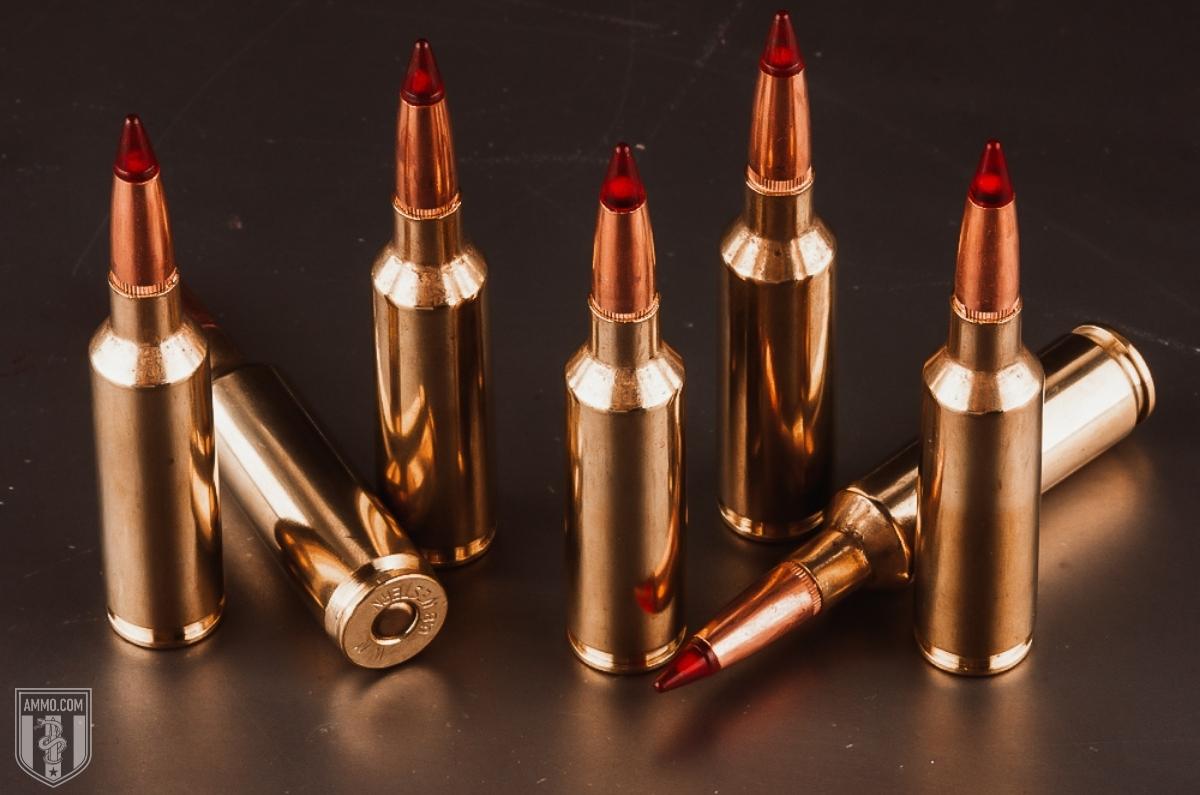
Although the 6.8 SPC seemed to be a potent answer to the 5.56 NATO terminal performance issue, there were some problems with its implementation.
Sadly, the chamber designs on the original 6.8 SPC cartridge were somewhat inaccurate, and the biggest issue was the free bore space at the mouth of the chamber.
The original chamber designs called for 0.050” of free bore, but combined with a 1:10 twist rate barrel, pressure issues began to creep up. Initial reports claimed that the rounds were only around 200 psi above the maximum 55,000 psi pressure limits, but if the military learned anything from Vietnam, it was to follow specs to the letter.
Remington sought to remedy the issue the best way they saw fit, which was to underload the ammo. As no one wants to shoot rounds that don’t live up to their full potential, the order was given for “Taps” to be played and the 6.8 SPC project was not adopted by the U.S. military.
However, in all the excitement over the new 6.8 SPC, several civilian firearm manufactures clambered to release rifles chambered in the new hotshot round before SAAMI had officially adopted the cartridge. With numerous faulty rifles in the wild, the only action SAAMI could take was to sanction the round.
This is not to say that original 6.8 SPC rifles won’t function properly, but there is the potential for a critical pressure failure when using full power rounds.
The answer was the 6.8 SPC II.
The 6.8 SPC II added an additional 0.050” of free bore to the chamber and decreased the barrel twist rate to 1:11. This completely solved the pressure issues experienced with the original design. All current rifles chambered in 6.8 SPC are actually chambered in 6.8 SPC II.
The 6.8 SPC II offers hunters an excellent intermediate cartridge option for small to medium game, while handloaders love the cartridge for its versatility. Capable of firing 85-140 grain bullets, the 6.8 SPC II allows reloaders the ability to load their ammo light for plinking and hot for hunting.
Although most factory loads will be loaded light (due to original 6.8 SPC rifles still in the wild), the 6.8 SPC II sits in the sweet spot between the ubiquitous 0.308” and diminutive 0.224” calibers. This offers shooters the power they need for medium game hunting without the increased recoil and heavier firearm (AR-10) associated with the 0.308.
To read more about the 6.8 Remington SPC, check out the full history of the cartridge on our 6.8 SPC history page.
Final Shots: 6.8 Western vs 6.8 SPC
The 6.8 Western and 6.8 SPC are two cartridges that are similar only in the fact that they fire the same diameter bullets.
The 6.8 Western is a big game hunter’s dream, combining the case capacity of the 270 WSM with the power of a 7mm Rem Mag into a short action rifle. Capable of felling elk at 500 yards or more, the 6.8 Western is a powerhouse long-range shooting cartridge that is beginning to gain ground in many hunting communities.
The 6.8 SPC was developed to increase the performance of the AR-15 and M4 carbine in CQB conditions. Although not officially adopted by the US Army, the 6.8 SPC can deliver considerably more kinetic energy into its target within 300 yards than standard-issue 5.56 NATO.
Although the 6.8 Western has bone crushing ballistics values, it is ill-suited for semi-automatic fire and is regulated to bolt-action rifles only. Likewise, the 6.8 SPC works well in CQB conditions but is not the best option for long range shots as its trajectory and kinetic energy drops like a rock past 300 yards.
Selecting the right cartridge primarily depends on what type of shooting you plan on engaging in. If you plan on big game hunting and shooting longer ranges, then the 6.8 Western is right for you. However, if you want a powerful semi-auto round that is great for deer hunting within 250 yards, then you should give the 6.8 SPC some serious consideration.
Regardless of which cartridge you choose, make sure you stock up on ammunition here at Ammo.com and I’ll see you on the range!
Ammo Comparisons
- .308 vs 5.56
- 6.5 Creedmoor vs .308
- .300 Blackout vs .308
- .300 Win Mag vs .308
- .243 vs .308
- .308 vs .30-06
- 7mm-08 vs .308
- .270 vs .308
- 7.62x39 vs .308
- .223 vs .308
- .338 Lapua vs .308
- .380 ACP vs 9mm
- .223 vs 5.56
- .300 Blackout vs 5.56
- 9mm vs 45 ACP
- 9mm vs 40 S&W
- .357 SIG vs 9mm
- 10mm vs 9mm
- 9mm vs 9mm Luger
- .243 vs .270
- .300 Win Mag vs .30-06
- .270 vs .30-06
- .40 vs .45
- 38 Special vs 357
- 9mm vs 40 vs 45
- 5.56 vs 7.62x39
- 338 Lapua vs .30-06
- .30-30 vs .30-06
- 300 PRC vs 338 Lapua
- .30-06 vs 7mm
- 300 Win Mag vs 338 Lapua
- 300 PRC vs 300 Win Mag
- 300 WSM vs 300 Win Mag
- 338 Win Mag vs 338 Lapua
- 12 Gauge vs 20 Gauge
- 10mm vs 357 Mag
- .30-30 vs 7.62x39
- 224 Valkyrie vs 22-250
- 17 HMR vs 22 Mag
- 7.62x39 vs .300 Blackout
- 45 ACP vs 45 Auto
- 45-70 vs 30-30
- 300 Blackout vs 223
- 357 Magnum vs 9mm
- 350 Legend vs 300 Blackout
- 224 Valkyrie vs 223
- 45 ACP vs 38 Super
- 6.5 Grendel vs .308
- 17 HMR vs 22 LR
- 10 Gauge vs 12 Gauge
- 22-250 vs 223
- 45 Colt vs 45 ACP
- 350 Legend vs 30-30
- 5.7x28 vs 223
- 5.7 vs 9mm
- 5.56 vs 5.7
- 22 vs 9mm
- Buckshot vs Birdshot
- 450 Bushmaster vs 308
- 450 Bushmaster vs 223
- Buckshot vs Slug
- 6.5 Grendel vs 5.56 vs 223
- 6mm ARC vs 6.5 Grendel
- 44 vs 45
- 458 SOCOM vs 5.56
- 357 vs 44
- 32 ACP vs 380
- 300 Win Mag vs 338 Win Mag vs 338 Lapua Mag
- 450 Bushmaster vs 458 SOCOM vs 50 Beowulf
- 6mm Creedmoor vs 6.5 Creedmoor
- TMJ vs FMJ
- 44 Special Vs 44 Magnum
- 45 90 vs 45 70
- 6.8 Western vs 6.8 SPC
- 50 Beowulf vs 50 BMG
- 26 Nosler vs 6.5 PRC
- 28 Gauge vs 410
- 6.8 SPC vs 5.56
- 6.8 SPC vs 6.5 Grendel
- 6.8 Western vs 7mm Rem Mag vs .28 Nosler
- 6.8 Western vs 6.5 Creedmoor
- 22 Hornet vs 223
- 6.8 Western vs 6.5 PRC
- .410 vs 12 Gauge
- .410 vs 20 Gauge
- 22 LR vs 22 Mag
- 6mm ARC vs 243
- 7mm-08 vs 270
- 243 vs 6.5 Creedmoor
- Nickel vs Brass Casing
- 204 Ruger vs 223
- 50 Beowulf vs 5.56
- 260 Remington vs 6.5 Creedmoor
- 6mm Remington vs 243
- 28 Nosler vs 300 PRC
- 50 Beowulf vs 50 AE
- 22 Nosler vs 22-250
- 450 Marlin vs 45-70
- 300 Win Mag vs 300 Norma
- 458 SOCOM vs 300 Blackout
- 38-55 vs 45-70
- 22 Hornet vs 22 LR
- 300 Norma vs 338 Lapua
- 338 Lapua vs 50 BMG
- 28 Nosler vs 300 Win Mag
- 28 Nosler vs 6.5 Creedmoor
- 204 vs 22-250
- 458 SOCOM vs 45 70
- 44 40 vs 45 70
- 6.8 SPC vs 6.5 Creedmoor
- 450 Bushmaster vs 30-06
- 7mm Rem Mag vs 300 Win Mag
- 30 Carbine vs 223
- 25-06 vs 30-06
- 26 Nosler vs 28 Nosler
- 16ga vs 12ga
- 30 06 vs 7.62 x54R
- 9mm Makarov vs 9mm Luger
- 350 Legend vs 223
- 30 Carbine vs 5.56
- 6.5x55 vs 6.5 Creedmoor
- 6.5 Creedmoor vs 270 vs 25-06
- M193 vs M855
- 450 Bushmaster vs 458 SOCOM
- 6.5 Grendel vs 6.5 Creedmoor
- 350 Legend vs 5.56
- .277 Fury vs 6.8 SPC
- 277 Fury vs 300 Win Mag
- 10mm vs .45 ACP
- 277 Fury vs 223
- 6.8 SPC vs 300 Blackout
- 6.5 PRC vs 6.5 Creedmoor
- 277 Fury vs 308
- 277 Fury vs 6.5 Creedmoor
- 350 Legend vs 450 Bushmaster
- 277 Fury Vs 5.56 NATO
- 10mm vs 40S&W
- 32 ACP vs 9mm
- 32 Special vs 9mm
- 8.6 Blackout vs 300 Blackout
- 30 Super Carry vs. 9mm
- 5.56 vs 9mm
- .50 Action Express vs 9mm
- 7.62x25 vs. 9mm
- 10mm vs 44 Magnum
- 300 Blackout vs 300 Win Mag
- 6.5 Grendel vs 300 Blackout
- 460 Rowland vs 10mm
- 300 RUM vs 300 PRC
- 300 Norma vs 300 PRC
- 45 GAP vs 45 ACP
- 7mm PRC vs 300 Win Mag
- 300 PRC vs 6.5 Creedmoor
- 300 PRC vs 308
- 357 SIG vs 357 Mag
- 7.62x39 vs 7.62x51
- 243 Win vs 223 Rem
- 30 Nosler vs 300 PRC
- 6.5 Creedmoor vs. 30-06 Springfield
- 450 S&W vs. 44 Magnum
- 6.5 Creedmoor vs. 300 Win Mag
- 454 Cassull vs. 45-70 Govt
- 454 Cassull vs. 44 Mag
- 7.62x54r vs. 308 Winchester
- 22 ARC vs. 223 Rem
- Subsonic vs. Supersonic Ammo
